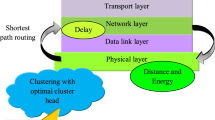Abstract
The optimal usage of scarce and inadequate resources is the current need of wireless sensor networks (WSNs). Reducing power consumption and increasing WSN’s lifetime can contribute to this. Energy-efficient algorithms should be proposed for effective routing, as a lot of energy is consumed during the communication between sensor nodes. A principal practice followed to bring down energy consumption is, combining together in-network data aggregation and standardized routing. Numerous conventional data aggregation algorithms exist, and each of these have their own disadvantages like delayed delivery of packets, time constraints, or high costs. The most suitable solution can therefore be achieved via optimization alone. The current research seeks to address these challenges faced in the wireless network by using the dual-cluster heads technique based on Krill Herd Optimisation (DC-KHO) Routing algorithm. Since the existing wireless routing approaches choose a random path for data transmission, the end- to- end delay, which is directly proportional to energy consumption, is high. So, the current study chooses an optimized path by calculating its path trust value using the devised krill herd maximization algorithm. The proposed DC-KHO algorithm is energy- efficient, and invariably amplifies the network’s lifetime. The study’s results reveal the ability of the proposed method in overcoming the challenges faced in transmission time, residual energy and computational time. Further, the method increases the life span of the network by 64.58%, when a 9 V battery is used for the nodes.










Similar content being viewed by others
Explore related subjects
Discover the latest articles and news from researchers in related subjects, suggested using machine learning.Change history
16 June 2022
This article has been retracted. Please see the Retraction Notice for more detail: https://doi.org/10.1007/s12652-022-04186-0
References
Al-karaki JN, Ul-mustafa R, Kamal AE (2009) Data aggregation and routing in wireless sensor networks: optimal and heuristic algorithms. Comput Networks 53:945–960. https://doi.org/10.1016/j.comnet.2008.12.001
Ari AAA, Damakoa I, Gueroui A et al (2017) Bacterial foraging optimization scheme for mobile sensing in wireless sensor networks. Int J Wirel Inf Netw 24:254–267. https://doi.org/10.1007/s10776-017-0359-y
Arora VK (2019) ACO optimized self-organized tree-based energy balance algorithm for wireless sensor network. J Ambient Intell Humaniz Comput. https://doi.org/10.1007/s12652-019-01186-5
Behera TM, Mohapatra SK, Samal UC et al (2019) Residual energy-based cluster-head selection in WSNs for IoT application. IEEE Internet Things J 6:5132–5139. https://doi.org/10.1109/JIOT.2019.2897119
Bhola J, Soni S, Kaur G (2019) Genetic algorithm based optimized leach protocol for energy efficient wireless sensor networks. J Ambient Intell Humaniz Comput. https://doi.org/10.1007/s12652-019-01382-3
Comput JPD, Ben-othman J, Yahya B (2010) Energy efficient and QoS based routing protocol for wireless sensor networks. J Parallel Distrib Comput 70:849–857. https://doi.org/10.1016/j.jpdc.2010.02.010
Dong M, Ota K, Liu A (2016) RMER: reliable and Energy-efficient data collection for large-scale wireless sensor networks. IEEE Internet Things J. https://doi.org/10.1109/JIOT.2016.2517405
Energy A, Selection EC, Networks WS, Studies C (2010) 2010 International conference on intelligent systems, modelling and simulation Ma Chaw Mon Thein Thandar Thein, pp 287–291. https://doi.org/10.1109/ISMS.2010.60
Feng X, Zhenzhen X, Lin Y, Weifeng S, Mingchu L (2010) Prediction-based data transmission for energy conservation in wireless body sensors. In: 2010 The 5th Annual ICST Wireless Internet Conference (WICON). IEEE, pp 1–9
Johnson DB (2011) PW-MAC: an energy-efficient predictive-wakeup mac protocol for wireless sensor networks, pp 1305–1313
Kandris D, Tsioumas P, Tzes A, Nikolakopoulos G, Vergados DD (2009) Power conservation through energy efficient routing in wireless sensors networks. Sensors (Basel). https://doi.org/10.3390/s90907320
Karaboga D, Basturk B (2008) On the performance of artificial bee colony (ABC) algorithm. Appl Soft Comput 8:687–697. https://doi.org/10.1016/j.asoc.2007.05.007
Khan R, Madani SA, Hayat K, Khan SU (2012) Clustering-based power-controlled routing for mobile wireless sensor networks. Int J Commun Syst. https://doi.org/10.1002/dac
Kuila P, Jana PK (2014) Engineering Applications of Artificial Intelligence Energy efficient clustering and routing algorithms for wireless sensor networks: particle swarm optimization approach. Eng Appl Artif Intell 33:127–140. https://doi.org/10.1016/j.engappai.2014.04.009
Kumar D, Aseri TC, Patel RB (2009) EEHC: energy efficient heterogeneous clustered scheme for wireless sensor networks. Comput Commun 32:662–667. https://doi.org/10.1016/j.comcom.2008.11.025
Liu G, Li Z, Zhou X, Li S (2007) Transmission power control for wireless sensor networks. In: 2007 Int Conf Wirel Commun Netw Mob Comput WiCOM 2007 12:2596–2599. https://doi.org/10.1109/WICOM.2007.646
Su S, Zhao S (2017) A hierarchical hybrid of genetic algorithm and particle swarm optimization for distributed clustering in large-scale wireless sensor networks. J Ambient Intell Humaniz Comput. https://doi.org/10.1007/s12652-017-0619-9
Villas LA, Boukerche A, Ramos HS et al (2013) DRINA: a lightweight and reliable routing approach for in-network aggregation in wireless sensor networks. IEEE Trans Comput 62:676–689
Wang G, Guo L (2013) A novel hybrid bat algorithm with harmony search for global numerical optimization. J Appl Math 2013:1–21. https://doi.org/10.1155/2013/696491
Xiang L, Luo J (2011) Compressed data aggregation for energy efficient wireless sensor networks. SECON. https://doi.org/10.1109/SAHCN.2011.5984932
Xiong YLN, Vasilakos YZAV, Jia JGY (2010) Multi-layer clustering routing algorithm for wireless vehicular sensor networks. IEEE Commun. https://doi.org/10.1049/iet-com.2009.0164
Zhou H-Y, Luo D-Y, Gao Y, Zuo D-C (2011) Modeling of node energy consumption for wireless sensor networks. Wirel Sens Netw 03:18–23. https://doi.org/10.4236/wsn.2011.31003
Author information
Authors and Affiliations
Corresponding author
Additional information
Publisher's Note
Springer Nature remains neutral with regard to jurisdictional claims in published maps and institutional affiliations.
This article has been retracted. Please see the retraction notice for more detail: https://doi.org/10.1007/s12652-022-04186-0"
About this article
Cite this article
Visu, P., Praba, T.S., Sivakumar, N. et al. RETRACTED ARTICLE: Bio-inspired dual cluster heads optimized routing algorithm for wireless sensor networks. J Ambient Intell Human Comput 12, 3753–3761 (2021). https://doi.org/10.1007/s12652-019-01657-9
Received:
Accepted:
Published:
Issue Date:
DOI: https://doi.org/10.1007/s12652-019-01657-9




